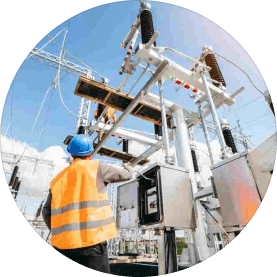Electrical Substation

An electrical substation is a critical component of the power
transmission and distribution system. It is an intermediary
infrastructure that transforms high-voltage electricity from
power plants into lower voltages suitable for local distribution.
Electrical substations play a vital role in maintaining a reliable
and efficient power supply to homes, businesses, and industries.
Substations contain the specialist equipment that allows the voltage of electricity to be transformed (or ‘switched’). The
voltage is stepped up or down through pieces of equipment called transformers, which sit within a substation’s site.Substations may be owned and operated by an electrical utility, or may be owned by a large industrial or commercial customer.
Electrical Substation
- CProject Scope and Objectives: Clearly define the project scope, including the purpose and requirements of the substation. Determine the voltage levels, capacity, and number of feeders needed based on the load demand and growth projections.
- Site Selection: Identify potential locations for the substation, considering factors such as proximity to power sources, load centers, accessibility, environmental impact, and land acquisition.
- Regulatory and Environmental Compliance: Understand and adhere to local and national regulations regarding substation design, construction, and operation. Perform environmental impact assessments and obtain necessary permits.
- Testing and Commissioning: After construction, conduct rigorous testing of the substation equipment and systems to verify their functionality and safety. Commission the substation to ensure it operates correctly and can handle the intended load.
- Maintenance and Operations Planning: Develop a comprehensive maintenance plan to ensure the substation's continued reliability and efficiency. Train personnel on operating procedures and safety protocols.
- Conveter Substations
- Mobile Substations
- Switching Stations
- Distubution Substations
- Transmission substations
- Collector Substations
- Converter substations
- Testing and Commissioning: After construction, conduct rigorous testing of the substation equipment and systems to verify their functionality and safety. Commission the substation to ensure it operates correctly and can handle the intended load.
- Maintenance and Operations Planning: Develop a comprehensive maintenance plan to ensure the substation's continued reliability and efficiency. Train personnel on operating procedures and safety protocols.
- Design and Engineering: Engage a team of experienced electrical engineers and designers to create detailed plans for the substation layout, equipment selection, grounding, protection systems, and control systems.
- Equipment Procurement: Source high-quality equipment, such as transformers, circuit breakers, switchgear, and control panels, from reputable suppliers.
- Construction Management: Select a qualified contractor to oversee the construction phase. Ensure that construction activities follow safety standards and are completed within the designated time and budget.
An electrical substation is a facility that serves as a junction point between electricity generation and electricity distribution. It gathers electricity from various sources, suchas electricity generation plants and electricity distribution networks, and then distributes it to end users across a wide area.

